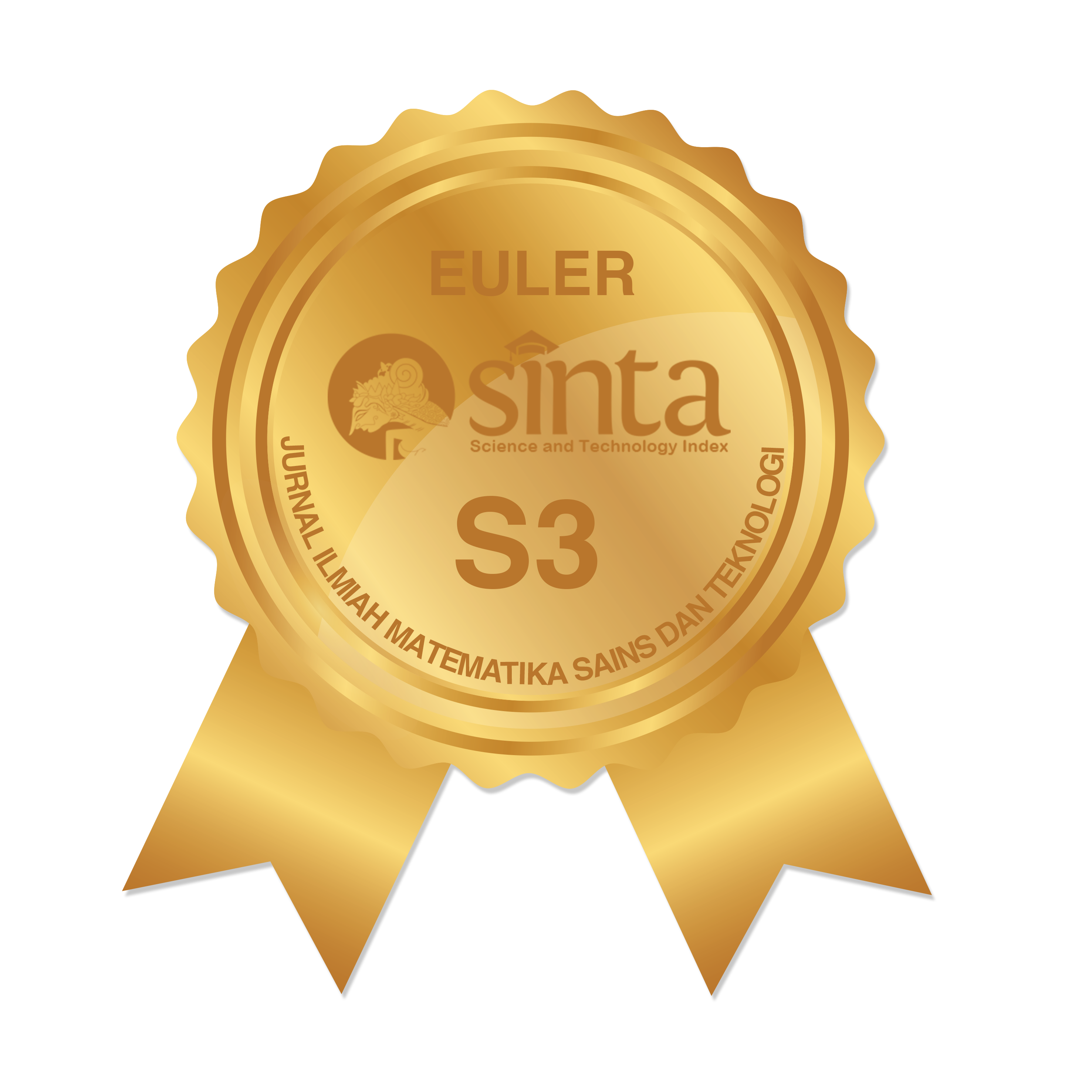Model Matematika SVEIAR Penularan Covid-19 di Indonesia dengan Intervensi Vaksinasi dan Tradisi Mudik
Abstract
In early 2020, the Covid-19 epidemic started in China, rapidly spreading across the globe, including Indonesia. Indonesian society is known for its diversity and complexity, making it difficult to predict trends in the number of infected, deceased, and recovered individuals. This study develops a Covid-19 transmission epidemic model, called SV EIAR, which accounts for interventions such as vaccination and the mudik tradition (the practice of returning to hometowns during Eid). In this model, the susceptible (S) compartment refers to the subpopulation of individuals who are susceptible to the virus, while vaccinated (V) represents those who have been vaccinated twice. The exposed (E) compartment includes individuals who are infected but still in the incubation period and unable to spread the virus. Infection (I) refers to individuals who are symptomatic, and asymptomatic (A) includes those who are infected but show no symptoms. Lastly, the recover (R) compartment represents individuals who have recovered from the infection. The analysis of the model involves identifying the reproduction number, estimating the disease-free and endemic equilibrium points, and analyzing their stability. Numerical simulations were carried out using Covid-19 transmission data from Indonesia to predict the trends of the infected and asymptomatic populations. The results suggest that the dynamics of Covid-19 cases are semi-stable in the susceptible (S), exposed (E), infected (I), and asymptomatic (A) compartments, meaning that these populations will increase over time. In a disease-free situation, the susceptible population (S) remains stable at a certain value, while other populations are stable at nearly zero. The susceptible population in the disease-free state is larger than during an epidemic, while other populations are smaller in the disease-free state compared to the epidemic. Additionally, the study found that vaccination can help reduce the transmission of Covid-19, while the practice of mudik can increase the spread of the virus.
Keywords
Full Text:
PDFReferences
D. Cucinotta and M. Vanelli, “WHO Declares COVID-19 A Pandemic,” 2020, Mattioli 1885. doi: 10.23750/abm.v91i1.9397.
Y.-C. Wu, C.-S. Chen, and Y.-J. Chan, “The Outbreak of COVID-19: An Overview,” Journal of the Chinese Medical Association, vol. 83, no. 3, pp. 217–220, Mar. 2020, doi: 10.1097/JCMA.0000000000000270.
D. N. Aisyah, C. A. Mayadewi, H. Diva, Z. Kozlakidis, Siswanto, and W. Adisasmito, “A Spatial-temporal Description of the SARS-CoV-2 Infections in Indonesia During the First Six Months of Outbreak,” PLoS One, vol. 15, no. 12, pp. 1–14, Dec. 2020, doi: 10.1371/journal.pone.0243703.
R. Djalante et al., “Review and Analysis of Current Responses to COVID-19 in Indonesia: Period of January to March 2020,” Progress in Disaster Science, vol. 6, pp. 1–9, Apr. 2020, doi: 10.1016/j.pdisas.2020.100091.
I. S. Iriany, R. Pasciana, A. Ramdhani, and Mulyaningsih, “Eid Homecoming ‘Mudik’ Tradition as A Conventional Pattern in the Global Era,” Journal of Advanced Research in Social Sciences and Humanities, vol. 4, no. 3, pp. 129–135, Jun. 2019, doi: 10.26500/JARSSH-04-2019-0306.
P. Utomo and Y. Zakky Umami, “Covid-19 Versus Mudik Telaah Tentang Efektivitas Kebijakan Pelarangan Mudik Lebaran pada Masa Pandemi Covid-19,” Jurnal Ilmu Hukum Qistie, vol. 14, no. 1, pp. 111–125, May 2021, doi: 10.31942/jqi.v14i1.4496.
A. P. S. Prasojo, Y. N. Aini, and D. Kusumaningrum, “Potensi Pola Aliran Mudik pada Masa Pandemi Covid-19,” Jurnal Kependudukan Indonesia, no. Edisi Khusus Demografi dan Covid-19, pp. 21–26, Jul. 2020, doi: 10.14203/jki.v0i0.579.
Y. Qi, “Mathematical Expression and Application of Marxism,” Applied Mathematics and Nonlinear Sciences, vol. 6, no. 2, pp. 543–552, Jul. 2021, doi: 10.2478/amns.2021.2.00105.
J. Panovska-Griffiths, “Can Mathematical Modelling Solve the Current Covid-19 Crisis?,” BMC Public Health, vol. 20, no. 1, Apr. 2020, doi: 10.1186/s12889-020-08671-z.
P. V. Khrapov and A. A. Loginova, “Mathematical Modelling of the Dynamics of the Coronavirus COVID-19 Epidemic Development in China,” International Journal of Open Information Technologies, vol. 8, no. 4, pp. 13–16, 2020.
L. A. Fauzia, “Analisis Pemodelan Matematika Penularan Covid-19 dengan Tindakan Rawat Inap di Rumah Sakit,” MATHunesa: Jurnal Ilmiah Matematika, vol. 9, no. 1, pp. 126–132, Jan. 2021, doi: 10.26740/mathunesa.v9n1.p126-132.
S. Kadyrov, A. Orynbassar, and H. B. Saydaliev, “Purely Data-driven Exploration of Covid-19 Pandemic After Three Months of the Outbreak,” Journal of Mathematical and Fundamental Sciences, vol. 53, no. 3, pp. 358–368, Dec. 2021, doi: 10.5614/j.math.fund.sci.2021.53.3.2.
A. S. Eegunjobi and O. D. Makinde, “Mathematical Analysis of Two Strains Covid-19 Disease Using SEIR Model,” Journal of Mathematical and Fundamental Sciences, vol. 54, no. 2, pp. 211–232, Dec. 2022, doi: 10.5614/j.math.fund.sci.2022.54.2.1.
R. I. Gweryina, C. E. Madubueze, and M. A. Nwaokolo, “Mathematical Modelling and Control of Covid-19 Transmission in the Presence of Exposed Immigrants,” Communication in Biomathematical Sciences, vol. 4, no. 2, pp. 93–105, Dec. 2021, doi: 10.5614/cbms.2021.4.2.2.
I. S. Joyosemito and N. M. Nasir, “Pendekatan Pemodelan Matematika Dinamis Dalam Analisis Prediksi COVID-19,” Jurnal Pengabdian kepada Masyarakat UBJ, vol. 4, no. 1, pp. 1–16, Jan. 2021, doi: 10.31599/jabdimas.v4i1.455.
A. Hasan et al., “Modeling COVID-19 Transmissions and Evaluation of Large Scale Social Restriction in Jakarta, Indonesia,” Communication in Biomathematical Sciences, vol. 5, no. 1, pp. 90–100, Aug. 2022, doi: 10.5614/cbms.2022.5.1.6.
R. Sunthornwat and S. Sookkhee, “Delay Time Parameter and Its Confidence Interval of Predictive Time Series of COVID-19 Outbreak Between the First and the Second Wave,” Journal of Mathematical and Fundamental Sciences, vol. 53, no. 2, pp. 305–322, Oct. 2021, doi: 10.5614/j.math.fund.sci.2021.53.2.9.
M. Chen, M. Li, Y. Hao, Z. Liu, L. Hu, and L. Wang, “The Introduction of Population Migration to SEIAR for COVID-19 Epidemic Modeling with an Efficient Intervention Strategy,” Information Fusion, vol. 64, pp. 252–258, Dec. 2020, doi: 10.1016/j.inffus.2020.08.002.
P. Shil, “Mathematical Modeling of Viral Epidemics: A Review,” 2016. [Online]. Available: http://www.brjnmims.org.
G. O. Fosu, E. Akweittey, and A. Adu-Sackey, “Next-Generation Matrices and Basic Reproductive Numbers for All Phases of The Coronavirus Disease,” Open Journal of Mathematical Sciences, vol. 4, no. 1, pp. 261–272, Dec. 2020, doi: 10.30538/oms2020.0117.
A. B. Gumel, E. A. Iboi, C. N. Ngonghala, and E. H. Elbasha, “A Primer on Using Mathematics to Understand COVID-19 Dynamics: Modeling, Analysis and Simulations,” Infect Dis Model, vol. 6, pp. 148–168, 2021, doi: 10.1016/j.idm.2020.11.005.
A. Chiu, “What Does Endemic Mean? Experts Answer Your Questions About The Future of Covid,” The Washington Post. Accessed: Nov. 20, 2022. [Online]. Available: https://www.washingtonpost.com/wellness/2022/01/20/what-does-endemic-mean/.
W. Winardi et al., Statistical Yearbook of Indonesia 2022. Jakarta: BPS, 2022. [Online]. Available: https://www.bps.go.id/id/publication/2022/02/25/0a2afea4fab72a5d052cb3.
Sekretariat, “273 Juta Penduduk Indonesia Terupdate Versi Kemendagri (273 Million Indonesian Population Updated Version of Ministry of Home Affairs),” Kementerian Dalam Negeri Republik Indonesia. Accessed: Feb. 24, 2022. [Online]. Available: https://dukcapil.kemendagri.go.id/phln/read/273-juta-penduduk-indonesia-terupdate-versi-kemendagri.
Humas, “Menkes Sebut Vaksinasi Covid-19 Akan Dimulai Pekan Depan,” Sekretariat Kabinet Republik Indonesia. Accessed: Jan. 08, 2023. [Online]. Available: https://setkab.go.id/menkes-sebut-vaksinasi-covid-19-akan-dimulai-pekan-depan/.
Y. Wang et al., “Characterization of an Asymptomatic Cohort of Severe Acute Respiratory Syndrome Coronavirus 2 (SARS-CoV-2) Infected Individuals Outside of Wuhan, China,” Clinical Infectious Diseases, vol. 71, no. 16, pp. 2132–2138, Nov. 2020, doi: 10.1093/cid/ciaa629.
R. T. Alqahtani, “Mathematical Model of SIR Epidemic System (COVID-19) with Fractional Derivative: Stability and Numerical Analysis,” Adv Differ Equ, no. 1, pp. 1–16, Dec. 2021, doi: 10.1186/s13662-020-03192-w.
Z. Gao et al., “A Systematic Review of Asymptomatic Infections with Covid-19,” Journal of Microbiology, Immunology and Infection, vol. 54, no. 1, pp. 12–16, Feb. 2021, doi: 10.1016/j.jmii.2020.05.001.
WHO, “Transmission of SARS-CoV-2: Implications for Infection Prevention Precautions,” WHO. Accessed: Aug. 08, 2022. [Online]. Available: https://www.who.int/news-room/commentaries/detail/transmission-of-sars-cov-2-implications-for-infection-prevention-precautions.
A. Septiani, “Tak Langsung Kebal, Butuh Waktu Bangun Antibodi Setelah Suntik Vaksin,” Berita Detikhealth. Accessed: Jan. 08, 2022. [Online]. Available: https://health.detik.com/berita-detikhealth/d-5328693/tak-langsung-kebal-butuh-waktu-bangun-antibodi-setelah-suntik-vaksin-covid-19.
N. P. Bestari, “Berapa Lama Tubuh Kebal Corona Usai Disuntik Vaksin Covid,” CNBC Indonesia. Accessed: Jan. 08, 2022. [Online]. Available: https://www.cnbcindonesia.com/tech/20210520185357-37-247152/berapa-lama-tubuh-kebal-corona-usai-disuntik-vaksin-covid.
DOI: https://doi.org/10.37905/euler.v13i1.30231
Refbacks
- There are currently no refbacks.
Copyright (c) 2025 Darsih Idayani, Asmara Iriani Tarigan, Selly Anastassia Amellia Kharis, Heny Kurniawati

This work is licensed under a Creative Commons Attribution-NonCommercial 4.0 International License.
Euler : Jurnal Ilmiah Matematika, Sains dan Teknologi has been indexed by:
EDITORIAL OFFICE OF EULER : JURNAL ILMIAH MATEMATIKA, SAINS, DAN TEKNOLOGI |
 | Department of Mathematics, Faculty of Mathematics and Natural Science, Universitas Negeri Gorontalo Jl. Prof. Dr. Ing. B. J. Habibie, Tilongkabila, Kabupaten Bone Bolango 96554, Gorontalo, Indonesia |
 | Email: euler@ung.ac.id |
 | +6287743200854 (WhatsApp Only) |
 | Euler : Jurnal Ilmiah Matematika, Sains dan Teknologi (p-ISSN: 2087-9393 | e-ISSN:2776-3706) by Department of Mathematics Universitas Negeri Gorontalo is licensed under a Creative Commons Attribution-NonCommercial 4.0 International License. Powered by Public Knowledge Project OJS. |















